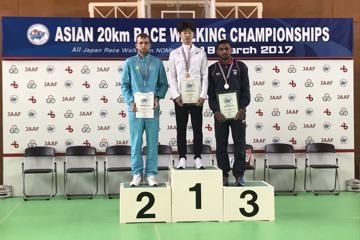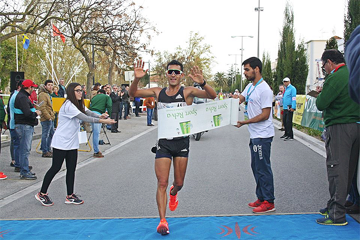Kimberley Garcia wins the 20km at the IAAF Race Walking Challenge meeting in Rio Maior (© Organisers)
You don’t often see surfing and race walking compared in the same breath - and walkers in Peru would prefer you didn’t.
But that’s pretty much the bone of contention for a group that has made massive strides in heel and toe over the last three years.
It grates on walkers that catching a wave catches attention better than the country’s walk achievements.
Some in official sports circles are keener to make more of a song and dance about their faves on the waves than the likes of IAAF Challenge winner Kimberley Garcia.
That’s because Peru are current surf team world champions - all well and good - but when it comes to minor sports, there appears little recognition of Garcia and co and their achievements.
Growing participation
Five years ago there was, maybe, 10 competing walkers in Peru. This year’s national championships in March saw more than 100 in all age categories and both sexes from 12 years upwards to 18.
Like neighbours Brazil, Ecuador and Colombia before them, Peru thinks its time for them to make an impact on the world’s walking scene.
Garcia inched the barriers open a bit more when the 29-year-old broke the tape at the IAAF Race Walking Challenge race at Rio Maior in March - the country’s first individual success on a global level.
She bided her time before passing Colombian Sandra Arenas to win in 1:31:00 - not Garcia’s fastest, but a victory all the same by 13 seconds. In fact, the Peruvian went 1:29:38 for 12th in the IAAF World Team Championships in Rome last year, and 14th at Rio’s Olympics.
“It shows the work I’ve made until now. I came here with a season’s best of 1:35 and I’ve improved to 1:31,” she offered.
It also suggests another win is in the offing at the XVIII Pan American Race Walking Cup in Lima on 13-14 May and a top 10 finish for the year’s real prize - the IAAF World Championships London 2017 in August.
The treasurer for Federación Deportiva Peruana de Atletismo (FDPA), Maria Letts, is delighted her country is catching up the other bastions of South American walking, but with hand on purse strings is all too aware they do it on the cheap.
She said: “Our yearly budget, not just for race walking but for the complete federation, is around 3,800,000.00 sol (approximately US, $1.1million) and that includes everything, even the two international events we are doing this year: Pan American Race Walking Cup and the Junior Pan American Championships.
“We got a lot less than we asked for when it came to race walking, and it seems there is a lasting fight with distance runners to get attention.
“They are more media attractive, but walks results are superior and still get little to no attention,” Letts explained.
“For example, Kimberly is among the world’s top athletes, while Gladys Tejeda, our best long distance runner is ranked 59th. On top of which, I hate being compared with surfing in terms of results - but some do.
“You can’t compare one with the other even if you have a world surfing champion in long board, as well.”
Turning point in Taicang 2014
Even so, Peru came of walking age at the 2014 World Walking Cup in Taicang, where progress was palpably measured by Pavel Chihuán’s 3:56:35 at 50k with various national bests en route, sixth for Paolo Yurivilca in the junior 10k and a 40:47 national record, and only a second behind fifth place, Garcia’s 1:29:44 in the women’s 20k, and a top-20 finish for Jéssica Hancco in the women’s junior 10k.
It was better still at the Rome version last year. Now re-branded as the World Team Championships, Peru even made it to the podium in the men’s junior event.
Investment, slim as it is, paid off for César Augusto Rodríguez and Lenyn Mamani, who claimed silver after finishing sixth and seventh in the junior.
Evelyn Inga set a new junior record and with Leyde Guerra in tow, Peru finished fifth in the U20 women’s team.
Yurivilca graduated to the senior 20k and set a new 1:21:49 national record, while García’s personal best was backed up by a three-minute PB for Jéssica Hancco and 1:33:20.
Little Peru made a clean sweep of entries when Luis Henry Campos recorded 4:05:47, a personal best and a seat for the short hop to Rio for the Olympic 50k.
13 walking centres
The next stage for the country is to unite the fragmented camps, who each have their own groups of walkers and somehow provide a super group to make even bigger strides towards the top.
There used to be just two centres of race walking, now there are 13, according to Letts, with three main groups of top walkers. El Tambo in Huancayo, south-east of the capital, Lima, Barranco in Arequipa in the south, and Puno in Puno, not far from the Bolivian border, host the best of the best.
She added: “The main coaches are Alfredo Quispe in Arequipa; Pedro Cañizares at El Tambo, and Salvador Paucar in Puno. It is mainly Alfredo Quispe and Pedro Cañizares work which has brought race walking to a higher level.”
García´s coach is Cañizares, a Cuban married in Perú and now nationalised.
“They do not work together…yet. That is a next step in their development,” said Letts.
Peru sought help and competition from four of their five neighbours on the country’s border to kick start their walks programme, and help was readily given.
“We are close with Colombia, Ecuador, Chile and Bolivia, and have been working together in some things during these last years,” Letts Explained.
“We had no experience, so we started five years ago during a yearly competition to which we invited them and they helped a lot in our development.”
A fond desire right now is to share equal billing on the back pages with ocean stars on boards.
Their best bet is that Garcia will make waves in London, and it will be her name Peruvians surf online to discover their next big hope for a major athletics medal.
Paul Warburton for the IAAF








